Hold ‘em poker might be all the rage, but 7 card stud is a poker throwback that has stood the test of time. Ready to learn more about this fast-moving, action-packed game? Today, we’re giving you everything you need to understand and win your next game of 7 card stud!
What’s So Great About This Game?
7 card stud is a vital member of the World Series of Poker championship and is the S in the H.O.R.S.E. series. Until the recent popularity of Texas hold ‘em, 7 card stud was the most popular form and was often what people played in homes. Because quite a few of each player’s cards are face up, opponents enjoy the opportunity to make more educated wagers as the game progresses. In fact, in most seven card stud variations there are four rounds betting, which puts you in a great opportunity to make a smart wager.
Poker itself has come a long way from its humble origins in China, the Middle East, and Europe. The game nearest to our current version of poker was known as “poque” by the French and landed in the United States by way of New Orleans. It quickly took off with riverboat sailors on the Mississippi river, who passed it to the different states they visited. It gained legendary status in the wild west but grew up a bit during the Civil War. With the advent of the Reno and Vegas casinos in the 1900’s, poker solidified its role in American hearts.
Today, it’s considered a sport, with coverage by ESPN, the sports network, and championship series that draw worldwide attention. It’s even the stuff of modern pop culture, with frequent mentions in famous movies like Rain Man, the 1980’s hit starring Tom Cruise and Dustin Hoffman, Casino Royale, the James Bond film featuring Daniel Craig, and Training Day, the 2001 movie about police corruption starring Denzel Washington and Ethan Hawke.
How to Play 7 Card Stud
Now that you know how great this game is, are you ready to learn how to play 7 card stud? Great! Let’s get started. Here’s what you need to know: the ante is the starting bid placed by the all the players. Some types of poker (such as Texas hold ‘em) don’t have an ante (hold ‘em uses a big blind and small blind), but this one does. Usually, players pay the minimum–there’s just no need to put in more at this point.
Players are then dealt two cards face-up, and one card face-down. At this point, the person with the lowest cards pays the bring-in, the opening bet for the round. Ties in card ranks are broken by suits; clubs are the lowest, then diamonds, then hearts, and then spades. Again, it’s common to play a low bring-in.
Now, a round of betting begins, starting to the left of the bring-in. Since cards are already face-up, the player can’t check (check indicates that she’s letting other players make decisions first) and must either call, raise, or fold.
Calling means that the player is betting the same as the buy-in. It keeps the player in the game without raising the stakes. If he feels like he’s got a strong hand, he can raise the bet and wager more than previous bets. If he decides his hand isn’t strong, he can fold, which means he puts in no more money for the rest of the game. A player indicates a fold but putting his or her cards face down on the table.
Lots of Betting
Once everyone at the table has either called, raised, or folded, it’s time for another round of cards. The dealer starts with the player on her left and proceeds clockwise to deal each person an upcard (dealer always starts with a burn card) and there is another round of betting. The first person to bet is determined by the person with the best upcards. Three of a kind, for example, would beat a high ace hand.
Next, there’s a third round. Each player gets another upcard, and everyone gets a chance to bet. This round is followed by a fourth round with an upcard and betting. The final, fifth round, receives a downcard and one last round of betting. If still, there are at least two players (and everyone hasn’t folded) there is a showdown. Players use the best five out of seven of their cards, and the winner takes the pot.
If you’re doing the math right now, you’ll quickly see that all these rounds are going to cause a card problem for more than six or seven players. If you’ve got eight players, and everyone stays till the showdown, you’ll need 60 cards. Since 7 card stud uses the standard 52-card deck, you might run into a problem!
Usually, however, you’ll find that most players (particularly if they’re experienced) will fold before the fifth round. Since previously-deal burn cards are never, ever re-used in the game (neither are folded cards), players might also opt for a single community card, dealt to the table on the final round.
How Hands are Scored
Classic poker hands are used in 7 card stud poker. Ties are made with the highest rank and then the highest suit.
Pairs
A pair is any two cards of the same rank, regardless of suit. A red queen and a black queen, for example, would be a pair. So would two black fives. Two pairs are more valuable than one pair. If you don’t have any pairs at only, your highest ranked card is what you compete with, but only against other high ranked cards. Cards outside of the pair are irrelevant, except that they’ll help you beat a tie.
Three of a Kind
Three of a kind is like a pair, but with a third card. That is, it’s three cards of the same rank. You might have two black sevens and a red seven, one black king and two red kings, or two black threes and a red three. This is not as common as a pair, but still fairly easy.
Straight
A straight involves five cards, so it’s quite a bit harder. All five cards must be in a sequence, but do not have to be in the same suit. For example, you might have a three, four, five, six, and seven in three different suits.
Flush
Similar to the straight, but opposite: in a flush, you have five cards that are not in sequence but that are in the same suit. The order doesn’t matter.
Full House
A full house is a three of a kind and a pair. Rare and difficult to get.
Four of a Kind
In a four of a kind, you’ve acquired every card from the same rank. For example, you’ve got four fours or four aces. The fifth card doesn’t matter (except to break a tie). This is a very valuable hand.
Straight Flush and Royal Flush
The five cards in a straight flush are both in sequence and in suit. A royal straight flush includes the royals–ace, king, queen, and jack. A straight flush might be a three, four, five, six, and seven of clubs, while a royal straight flush would be the ace, king, queen, jack, and ten of the same suit (say, hearts). A royal flush beats a straight flush, but these two are the highest possible hands in 7 card stud.
7 Card Stud Variations
As always, poker is full of variations and this game is no exception. There are a handful of popular variations to the classic 7 card stud rules. Seven card stud high low, for example, splits the pot with the lowest qualifying hand. To qualify as the low hand, your hand has to be lower than eight, seven, six, five, four, and aces can be high or low.
Another popular variation is Mississippi stud, when nixes the betting round after the fourth card so that there are only four rounds. In this game, the final card is dealt face up, so it’s both faster than normal 7 card stud and more like Texas hold ‘em in the number of up and down cards.
Smart Strategy
Poker is first and foremost a game of patience. Players who go in aggressively, consistently, won’t see great results. However, players who make smart folds to grab bigger wins with strong hands do better in the long run.
One of the best strategies is to play what’s called a live hand. Because you have the benefit of seeing cards on the table, you’ll know that if a lot of, say, diamonds are on the table, and you have diamonds, you have a dead hand since there aren’t many diamonds left in the deck. Similarly, if you’ve only got one or two suited cards showing, you’re in a good position and should likely keep playing.
Think ahead, don’t let the adrenaline get to you, and don’t hesitate to fold if you don’t have a strong hand. Keep this advice in mind, and you can expect great results at your next 7 card stud game!

